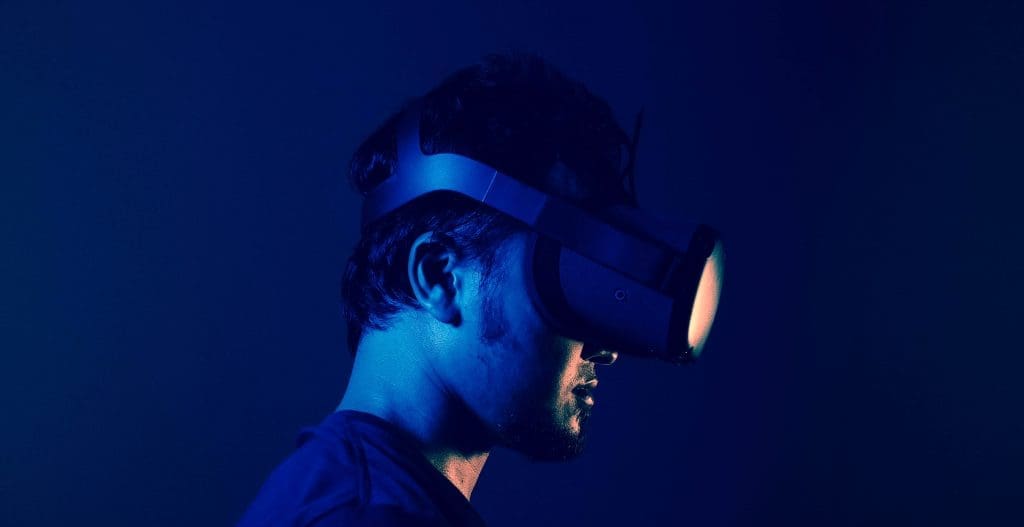With all of these new terms being used more and more, it can be difficult to keep up.
This is why we thought it’d be useful to create an article explaining some of the key differences between the metaverse and Virtual Reality (VR).
We will also talk about Augmented Reality (AR), Extended Reality (XR) and Mixed Reality (MR) and how they fit together with the metaverse and virtual reality.
Is the metaverse VR, AR or both?
- 1 Is the metaverse VR, AR or both?
- 2 Do you need VR for the metaverse?
- 3 What is XR (Extended Reality) and MR (Mixed Reality)?
- 4 Does the metaverse need a ‘killer app’ that pushes it into the mainstream?
- 5 How will the metaverse evolve in the coming years?
- 6 Conclusion: will more companies soon be investing in the metaverse and virtual reality experiences?
To start with, the metaverse is best thought of as an ‘always on’ persistent virtual world. Users interact with these worlds and other users typically through VR, which stands for ‘virtual reality‘.
AR stands for ‘augmented reality’ and is usually used to describe experiences where the real world and digital virtual world seamlessly combine together. A popular example of this is the mobile phone game/app named Pokemon Go.

Photo by David Grandmougin on Unsplash
In the example of Pokemon Go, the real world is shown on your screen as the environment. Then, with the clever use of the phone camera and GPS, Pokemon (which are virtual animals) can be rendered and placed into the real-world environment. This mixture of the physical world with digital virtual creations is described as AR or augmented reality.
Virtual worlds that are experienced through VR are different as they don’t render live feeds or data from the real world. Typically in a VR environment, the whole scene is created with digital assets that aren’t linked to the physical world. To understand more about the differences between VR and AR, please read more here.
Do you need VR for the metaverse?
When it comes to the metaverse, things aren’t as clear cut.
The metaverse can be experienced without VR hardware, but due to the nature of how the whole thing works, a VR headset enhances the experience enormously. This is not because most of the metaverse environments are created with virtual reality in mind, but more that they are optimised for a set visual perspective best experienced in VR.
Many popular metaverse experiences such as Decentraland do not need, or even have a VR experience at the time of writing.
Although metaverse worlds aren’t typically considered AR worlds, experiences are augmented between the physical and digital worlds. For example, music files and other information can be transferred to metaverse worlds that are identical to those in the physical world.
Many new users may not like the idea of wearing a bulky headset in order to experience what the metaverse has to offer. The good news is, that modern headsets like the Oculus Quest 2 are compact and don’t have any cables to worry about (unless connected to PC).
There will likely be multiple apps and pieces of software that can interface and interact with metaverse worlds. It’s easy to imagine that you will have your ‘main’ metaverse experience which is using VR and other traditional apps that integrate with metaverse events. So it’s not ‘all or nothing’ when it comes to getting involved with metaverse experiences using VR headsets.

VR and AR are different but can provide similar user experiences. Photo by Minh Pham on Unsplash
What is XR (Extended Reality) and MR (Mixed Reality)?
If AR and VR wasn’t enough, let’s discuss more jargon below:
- XR, or “Extended Reality”, is an umbrella term that is used to encompass VR, AR and MR (mixed reality) experiences. This is commonly used to describe interfaces or experiences that combine both real-world scenes that are augmented through digital AR technology, with digital worlds and environments. This can include games, metaverse world experiences and novelty apps.
- MR or “Mixed Reality” is used to describe the ‘interweaving’ of the physical world and digital world. These worlds or pieces of software can be thought of as ‘hybrid’ experiences. MR experiences can be seen in certain medical operations or advanced procedures that use both physical and digital images or video to enhance the task or job at hand. MR can be thought of as more interactive than just AR alone, which typically superimposes static images or assets onto environments.
Does the metaverse need a ‘killer app’ that pushes it into the mainstream?
This is a common question that a lot of people are asking currently as the metaverse is still new territory for a lot of casual users of VR.
The best way to think about this is to realise that the metaverse isn’t just one world or experience, it’s a term described to cover all persistent 3D virtual and sometimes non-virtual worlds.
This means that there will be many different worlds with different goals and objectives that focus on how to best serve its users.
Both Decentraland and the play-to-earn metaverse game AXIE Infinity offer unique worlds, powerful tools for interaction and huge incentives to users. These metaverse worlds are becoming increasingly popular and ever more appealing to casual audiences.
Meta is invested heavily in the metaverse, working on multiple experiences — one of which is Horizons — and have said that they are committed to metaverse experiences for the long term.
Some metaverse worlds won’t necessarily need a killer app if its focus is solely on interaction and social experiences. Other metaverse worlds may rely more on gaming and entertainment which would mean it would likely need a killer app in order to bring people in.
How will the metaverse evolve in the coming years?
Over the next few years we can expect the number of users using metaverse worlds to rise dramatically.
With the latest gaming consoles such as the PlayStation 5 launching their second iteration of the PSVR headsets, we can expect VR and virtual worlds to be accessible to more and more users.
We will also see in the coming year Oculus’ new headset improving on the previous design and hardware, allowing users to be more immersed than ever.
Meta has stated on multiple occasions that they are investing heavily in metaverse experiences along with many big NFT projects taking off in the space. The metaverse will continue to be attractive to both investors, marketers and casual users in the coming years.
We can expect the utility and usage cases to be taken more seriously as the user base grows and technology develops. As long as there are customers to reach and marketing potential, businesses will be experimenting with advertising in the metaverse at an increasing rate.
Conclusion: will more companies soon be investing in the metaverse and virtual reality experiences?
It’s easy to imagine companies like Apple and Samsung getting onboard with metaverse and virtual reality experiences.
Apple is no stranger to experimenting around with AR and have many apps on their app store that push AR experiences to new highs. Although Apple doesn’t offer VR compatible headsets, we’ve repeatedly seen how mobile phones can be utilised for VR.
Like Meta, Apple has the deep pockets required for heavy investment allowing them to potentially develop unique experiences within digital virtual worlds. It’s not too far-fetched to imagine Apple Wallet integration in metaverse worlds allowing for the purchase of digital and virtual items approved by Apple.
Apple has a large device ecosystem so it seems like a great opportunity to create their own version of a metaverse world and integrate their Apple Watch and iPhone devices within the metaverse experience. Users could receive notifications informing them about metaverse events or the status of your digital property/assets in the virtual world.
This article is part of our latest series on the metaverse and what this means for businesses. To jump straight to one of our other titles, please feel free to browse below:
- What Is the Metaverse & What Are NFTS? What Does This Mean for Business?
- Are The Metaverse And Virtual Reality The Same Thing? What About XR & MR?
- Is Metaverse Social Media Marketing a Trend to Watch in 2022?
- Is Metaverse SEO (Or Should We Say Meta SEO) The Future of Search Marketing?
- Should Businesses Think About Metaverse Marketing as Part of Their Digital Strategy?
- Leading Metaverse Companies, Projects & Examples: Who Will Win the Race?
What are your thoughts on the metaverse and virtual reality, AR, XR, MR and everything in between? Do you think the metaverse and virtual reality are here to stay, or just a temporary fad? Be sure to leave us a comment to let us know.






A great and well-written article that cleared my mind about XR & MR. This beginner-friendly article is what everyone needs to understand: metaverse, VR, AR, XR, and MR. I will recommend this article to my friends.
Thanks for the recommendation. There’s a lot of jargon to digest in this one but these technologies are all becoming more mainstream and more intertwined.
A great resource for understanding the Metaverse and Virtual Reality, specifically the different technologies such as AR, XR and MR. It covers the history and current state of these technologies, and how they are expected to shape the future of the Metaverse. It is a great read for those interested in how technology is shaping the future of human interaction and experiences.